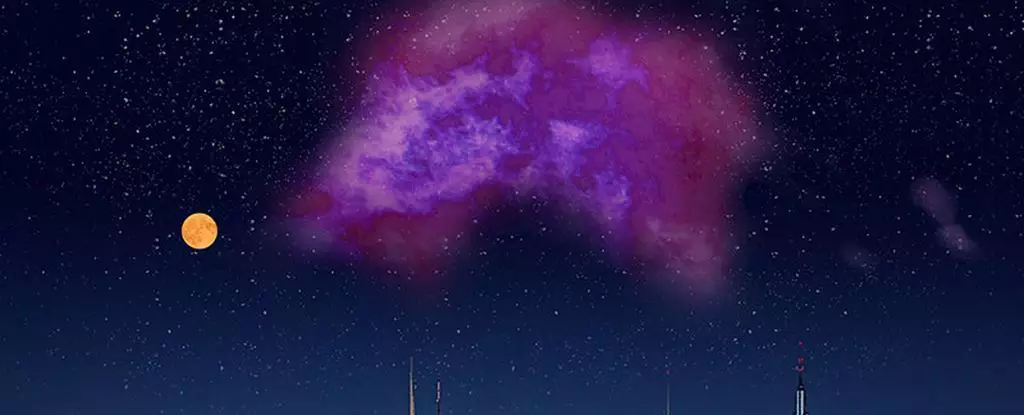Astrophysics is witnessing a revolution with the recent unveiling of a colossal molecular cloud named Eos. Positioned just 300 light-years away at the edge of our Solar System’s Local Bubble, Eos defies the conventional narrative of dense stellar nurseries. Unlike nebulae that are visually arresting and brimming with vibrant stellar creation, Eos is a crescent-shaped cloud composed of molecular hydrogen—the elemental core of everything that exists in our universe. This groundbreaking discovery, which achieved visibility through the flaring emissions of far-ultraviolet light, marks a profound advancement in astrophysical exploration and challenges our fundamental understanding of interstellar matter.
Breaking the Silence of Interstellar Space
For centuries, the night sky has captivated human imagination, presenting a vast canvas punctuated by twinkling celestial bodies. However, beneath the ethereal facade lies an abundance of molecular material that has eluded astronomical scrutiny until now. Historically, the spaces between stars were thought to be voids, but they teem with hydrogen gas that can sometimes conglomerate into clouds. Eos’s detection epitomizes a paradigm shift where researchers no longer just rely on conventional tracers such as carbon monoxide but instead innovate techniques to observe otherwise invisible celestial entities.
Dr. Blakesley Burkhart from Rutgers University emphasizes the distinctiveness of Eos: “This is the first-ever molecular cloud discovered by looking for far-ultraviolet emission of molecular hydrogen directly.” Utilizing observations from South Korea’s STSat-1 ultraviolet space telescope, the research team adeptly identified the fluorescence emitted by hydrogen molecules, signifying an urgent need to rethink the methods employed to explore our cosmic surroundings.
The Size and Significance of Eos
Eos challenges our preconceptions about the scale and visibility of celestial formations. Estimated to be about 80 to 85 light-years in diameter and containing approximately 2,000 solar masses of hydrogen, Eos is monumental—essentially, if it could be seen from Earth, it would dominate the night sky at 40 times the width of a full Moon. Yet, what is even more compelling is the understanding of its lifecycle. Eos is experiencing a process known as photodissociation, where energy from surrounding stars is causing it to dissipate slowly. At a depletion rate of approximately 600 solar masses per million years, this majestic cloud risks total obliteration in as little as 5.7 million years—a fleeting moment in cosmic terms.
The Implications of Eos for Stellar Formation
Eos’s revelation has significant implications for our understanding of star and planet formation. As astronomers like Burkhart posit, the molecular cloud enables a firsthand examination of how interstellar gas and dust morph into stellar structures. The ability to directly observe these processes allows scientists to begin constructing a more precise narrative around galactic evolution, addressing long-standing questions about the formation and lifecycle of stars.
Cosmologist Thavisha Dharmawardena articulates the broader implications succinctly: “The use of the far-ultraviolet fluorescence emission technique could rewrite our understanding of the interstellar medium, uncovering hidden clouds across the galaxy.” Eos thus serves as both a landmark discovery and a beacon, guiding future explorations of the unseen complexities of our universe.
New Frontiers in Cosmic Discovery
The unveiling of Eos represents more than just a singular finding in the realm of astrophysics. It signals a newfound potential for detecting additional molecular clouds that may exist throughout the Milky Way and beyond. As researchers refine their methodologies and expand their observational techniques, we may soon find a plethora of similar phenomena waiting to be explored, reshaping our conception of interstellar space itself.
With Eos at the forefront, the scientific community is galvanizing around this breakthrough. The path has been paved for a series of explorations that could unearth the vast and latent remnants of cosmic dawn, exposing the hidden intricacies of the galaxy’s evolutionary journey. The stakes are high: interpolating these discoveries could lead to significant revelations about the origins of life, the mechanics of star formation, and the very nature of our universe.
The recurrent theme of human curiosity is undeniable in this field—transforming the way we perceive our cosmic neighborhood is not merely an academic endeavor but an intrinsic aspect of our pursuit to understand our place within the universe. The discovery of Eos thus garners not only scientific importance but also serves as a testament to humanity’s relentless quest for knowledge, illuminating the shadows of our ignorance with the light of inquiry and discovery.

